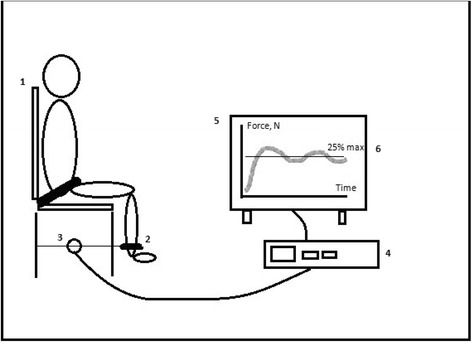Fig. 3.

Study setup for biomechanical measurements of the lower limbs. 1: Custom-made chair, where the participant will be seated, back straight, with 90 degree flexion in the hip, 90 degree flexion in the knee, to ensure that the lower leg is in a vertical position. A safety strap will be fastened at the hip and hands held in the lap. 2: A strap will be fastened around the ankle, ensuring that the rigid transducer arm (3) is horizontal. 3: Strain-gauge transducer. 4: Computer with software for data collection. 5: Screen, where the participant will get visual feedback during endurance testing. A line will be marked on the screen (6), representing 25 % of the participants’ maximal voluntary contraction (MVC). Made with inspiration from J.B. Poulsen and colleagues [47]. The following measurements will be performed: the maximal voluntary contraction (MVC) and rate of force development (RFD). The participant is carefully instructed, using the same wording every time, to “stretch your leg as forcefully and as quickly as possible.” When maximal tension has been reached, it is maintained for 1–2 s and then released. The peak of the force-time curve is the MVC. The steepest slope of the curve is the RFD. Endurance: 25 % of the participants’ MVC will be calculated, and a line will be depicted on the screen. The participant will be instructed to exert a force sufficient to reach the line, not more, not less. The participant will maintain this force for as long as possible, though maximally 3 min. The participant will have constant visual feedback and standardized verbal encouragement, if needed
